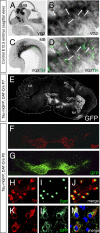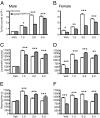VGLUT2 in dopamine neurons is required for psychostimulant-induced behavioral activation
- PMID: 20018672
- PMCID: PMC2806710
- DOI: 10.1073/pnas.0910986107
VGLUT2 in dopamine neurons is required for psychostimulant-induced behavioral activation
Abstract
The "One neuron-one neurotransmitter" concept has been challenged frequently during the last three decades, and the coexistence of neurotransmitters in individual neurons is now regarded as a common phenomenon. The functional significance of neurotransmitter coexistence is, however, less well understood. Several studies have shown that a subpopulation of dopamine (DA) neurons in the ventral tegmental area (VTA) expresses the vesicular glutamate transporter 2 (VGLUT2) and has been suggested to use glutamate as a cotransmitter. The VTA dopamine neurons project to limbic structures including the nucleus accumbens, and are involved in mediating the motivational and locomotor activating effects of psychostimulants. To determine the functional role of glutamate cotransmission by these neurons, we deleted VGLUT2 in DA neurons by using a conditional gene-targeting approach in mice. A DAT-Cre/Vglut2Lox mouse line (Vglut2(f/f;DAT-Cre) mice) was produced and analyzed by in vivo amperometry as well as by several behavioral paradigms. Although basal motor function was normal in the Vglut2(f/f;DAT-Cre) mice, their risk-taking behavior was altered. Interestingly, in both home-cage and novel environments, the gene targeted mice showed a greatly blunted locomotor response to the psychostimulant amphetamine, which acts via the midbrain DA system. Our results show that VGLUT2 expression in DA neurons is required for normal emotional reactivity as well as for psychostimulant-mediated behavioral activation.
Conflict of interest statement
L.O. is co-owner of a company owning the commercial rights to a genetic mouse model of Parkinson’s disease, the generation of which requires use of the DAT-Cre mouse. None of the other authors declare any conflict of interest.
Figures



References
-
- Hökfelt T. Neuropeptides in perspective: The last ten years. Neuron. 1991;7:867–879. - PubMed
-
- Bellocchio EE, Reimer RJ, Fremeau RTJ, Jr, Edwards RH. Uptake of glutamate into synaptic vesicles by an inorganic phosphate transporter. Science. 2000;289:957–960. - PubMed
-
- Fremeau RTJ, Jr, et al. The expression of vesicular glutamate transporters defines two classes of excitatory synapse. Neuron. 2001;31:247–260. - PubMed
Publication types
MeSH terms
Substances
LinkOut - more resources
Full Text Sources
Molecular Biology Databases

